Impact of Analytics on Meeting Productivity
Discover how analytics can revolutionize meeting productivity by optimizing schedules, enhancing engagement, and driving strategic decision-making...
Enhance executive decision-making with meeting analytics, optimizing efficiency, collaboration, and strategic planning for better business outcomes.
Informed decision-making is crucial at the executive level, as it directly influences an organization's strategic direction and success. Executives must rely on accurate, timely, and relevant information to make decisions that drive growth, innovation, and competitive advantage. This is where meeting analytics come into play, providing critical insights into the dynamics of meetings.
Meeting analytics help executives understand patterns in participation, engagement, costs, and decision-making efficiency. By leveraging these insights, leaders can optimize meeting structures, improve collaboration, and ensure that decisions are well-informed and strategically sound. The use of meeting analytics supports a data-driven approach to strategic planning, enhancing overall organizational performance.
Implementing meeting analytics not only helps in making better decisions but also in tracking the effectiveness of these decisions over time, ensuring continuous improvement and alignment with the organization's goals.
Meeting analytics involves the systematic collection, analysis, and utilization of data related to meetings. This process aims to optimize meeting efficiency, enhance decision-making, and improve overall organizational productivity. By leveraging various data points, meeting analytics provides insights into how meetings are conducted, who participates, and the outcomes achieved. Key metrics include:
Engagement metrics focus on how actively participants are involved in meetings. This includes tracking attendance rates, participation levels, and the frequency of contributions. High engagement is crucial for effective meetings, as it ensures diverse viewpoints are considered and participants are more invested in the outcomes. Attendance analytics can reveal patterns in who attends meetings and how often, which helps in understanding engagement levels and identifying areas for improvement.
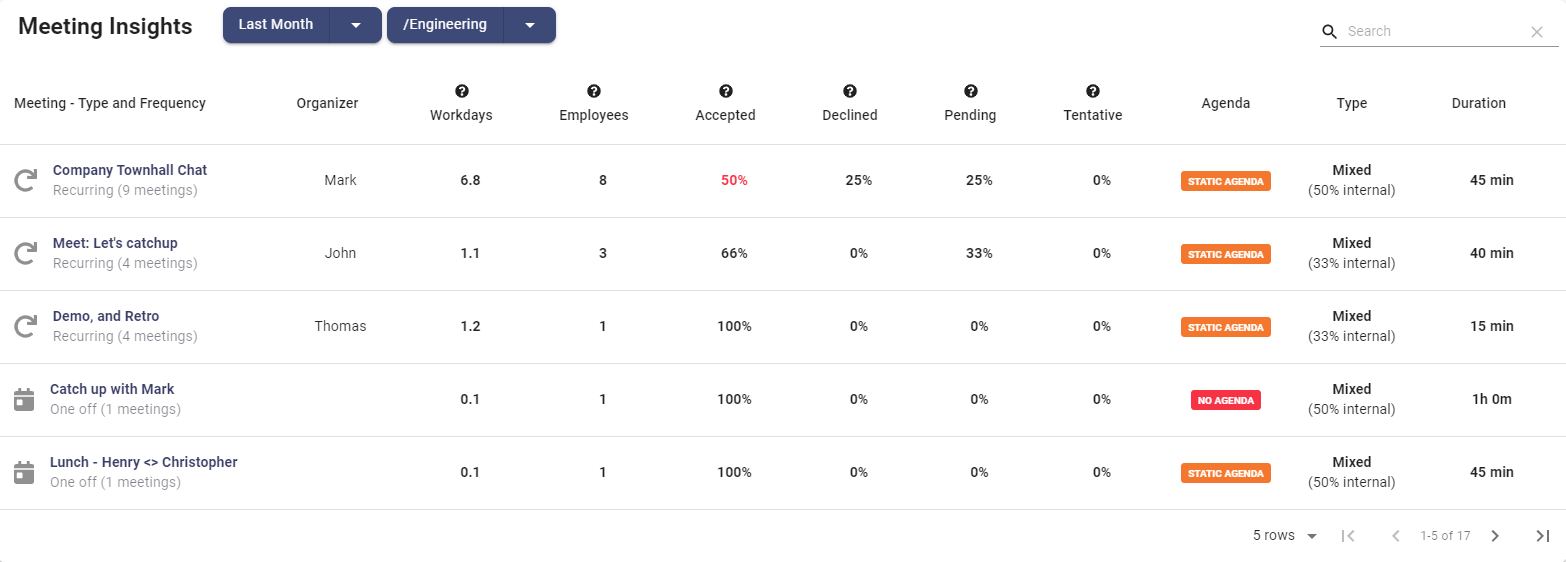
This metric measures how effectively meetings lead to decisions. It includes the speed and clarity of decisions made, as well as the effectiveness of those decisions in achieving desired outcomes. Efficient decision-making is critical for maintaining momentum and ensuring that meetings are productive. According to McKinsey, data-driven organizations that incorporate qualitative and quantitative insights tend to have sharper decision-making processes, which can enhance overall business performance.
Follow-through metrics assess how well decisions and action items from meetings are implemented. This includes tracking the completion of assigned tasks and the progress of ongoing projects. Effective follow-through ensures that meetings lead to tangible results and that there is accountability for actions decided upon during meetings. As noted by INFORMS, establishing clear goals and aligning them with the organization's strategic objectives is vital for ensuring successful follow-through and achieving positive impacts from meeting decisions.
By focusing on these key metrics, organizations can gain a comprehensive understanding of their meeting dynamics and make informed decisions to enhance meeting effectiveness and drive better business outcomes.
Begin by determining which metrics are most relevant to your executive decision-making processes. Common metrics include meeting frequency, duration, attendance, participation levels, decision-making efficiency, and follow-through on action items. Set clear, measurable goals for these metrics to track improvements and outcomes over time.
Utilize meeting analytics with Flowtrace to automatically collect and analyze meeting data. Ensure that these tools integrate seamlessly with existing platforms such as Google Calendar, Microsoft Outlook, Slack, and other communication and collaboration tools.
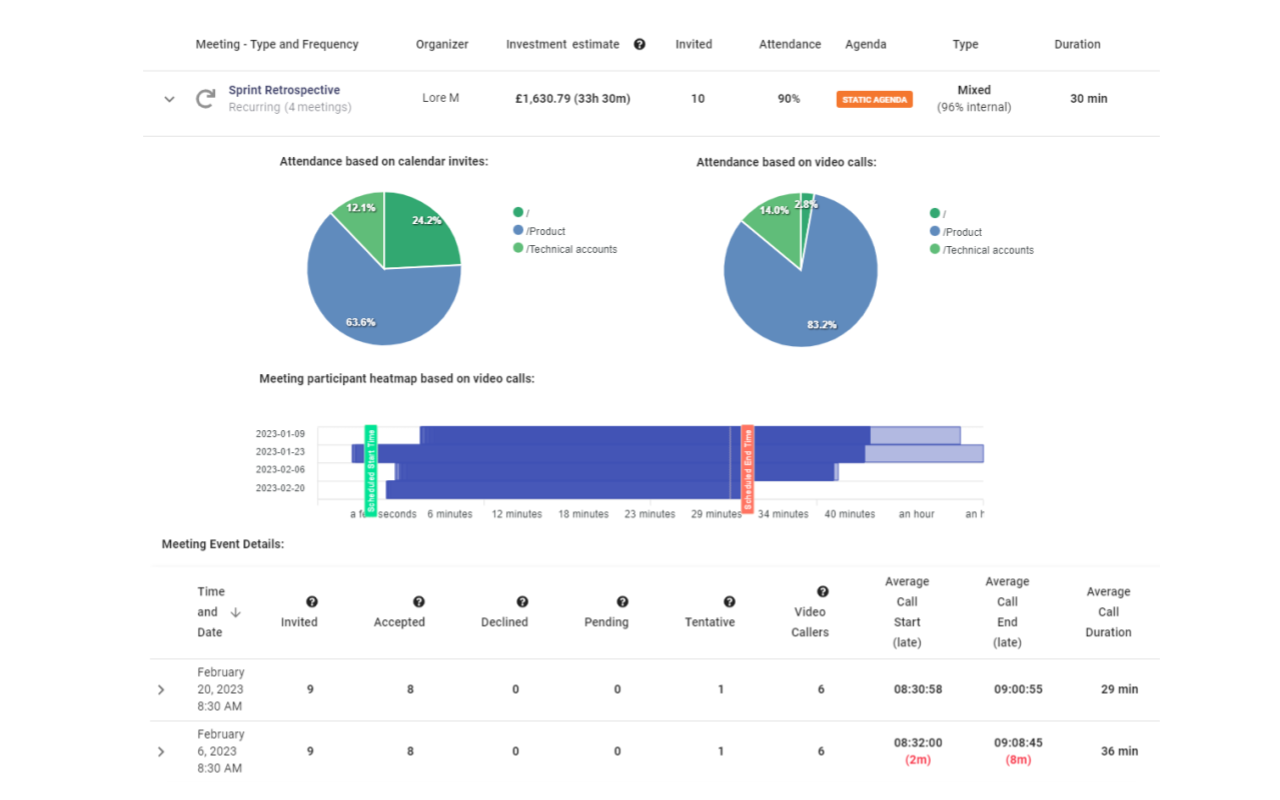
According to McKinsey, companies that leverage data analytics in decision-making processes are 19 times more likely to be profitable, underscoring the importance of integrating robust data collection tools.
Regularly review the collected data to identify trends, inefficiencies, and areas for improvement. Use data visualization techniques to make the insights more accessible and actionable for executives.
Harvard Business School notes that 56% of companies report more effective decision-making as a result of using data analytics.
Use the insights gained from meeting analytics to inform strategic decisions. This includes adjusting meeting structures, improving agenda planning, and ensuring that meetings are aligned with organizational objectives.
Ensure that decisions are data-driven by presenting relevant metrics and insights during executive meetings. This practice helps in making informed and objective decisions.
Continuously monitor the impact of implemented changes on meeting efficiency and decision-making quality. Use this feedback loop to make iterative improvements.
Regular reviews and adjustments ensure that the analytics remain relevant and aligned with the evolving business goals.
By integrating meeting analytics into executive processes, organizations can enhance the quality of their strategic decisions, align meetings with business objectives, and ultimately drive better business outcomes.
Effective executive decision-making relies on precise and actionable insights derived from meeting analytics. By focusing on specific metrics, executives can ensure that their decisions are well-informed and aligned with organizational goals. Key metrics to consider include tracking engagement and participation, measuring decision-making speed and effectiveness, and analyzing follow-up actions and outcomes.

By focusing on these key metrics, executives can gain a comprehensive understanding of their meeting dynamics and make more informed decisions. Utilizing tools like Flowtrace to track and analyze these metrics can provide valuable insights, driving better business outcomes and ensuring that executive decision-making is both efficient and effective.
Use descriptive statistics to summarize and understand past meeting behaviors. This involves calculating metrics such as average meeting duration, frequency, and participation rates. Visual tools like histograms and bar charts can help present these statistics in an easily digestible format.
Apply diagnostic techniques to understand the causes of specific meeting outcomes. For instance, if engagement levels are low, analyze the data to pinpoint whether it’s due to poor timing, irrelevant content, or lack of participant involvement. Techniques such as root cause analysis and correlation studies can help in identifying the underlying issues affecting meeting effectiveness.
Leverage predictive analytics to forecast future meeting outcomes based on historical data. This can help in planning and optimizing future meetings. For example, using regression analysis to predict the impact of meeting frequency on decision-making efficiency. Advanced tools and algorithms can be used to create predictive models that help in anticipating and mitigating potential issues.
Use prescriptive analytics to recommend actions based on the data insights. This involves simulating different scenarios and their potential outcomes to guide decision-making. Techniques such as decision trees and optimization algorithms can provide actionable recommendations for improving meeting structures and processes.
By applying these techniques, organizations can effectively interpret meeting data and utilize the insights to make strategic decisions. Ensuring data accuracy and reliability further strengthens the foundation for data-driven decision-making, leading to improved meeting efficiency and overall organizational performance.
Define the purpose and desired outcomes of each meeting in advance. Ensure that all participants understand these objectives to stay focused and productive. Create detailed agendas that outline the topics to be covered and allocate specific time slots for each item. Distribute the agenda ahead of time to allow participants to prepare adequately.
Shorter meetings tend to be more productive, aim to keep meetings concise and to the point. Implement strict start and end times to prevent meetings from dragging on. Consider adopting the "stand-up meeting" format for quick updates and discussions.

Foster an inclusive environment where all participants feel comfortable contributing. Use techniques like round-robin discussions to ensure everyone has a chance to speak. Utilize digital tools for real-time interaction, such as live polling and collaborative documents, to engage participants actively.
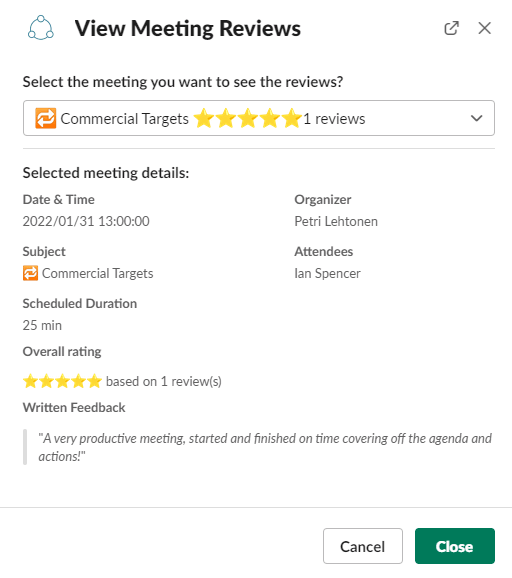
Implement strong data security protocols, including encryption, access controls, and regular security audits, to protect sensitive information. Ensure compliance with relevant data protection regulations (e.g., GDPR, CCPA) to maintain trust and legal compliance.
Be transparent about data collection practices and obtain consent from all participants. Clearly communicate how the data will be used and the benefits it will provide. Address any concerns promptly and ensure that data privacy policies are easily accessible and understood by all stakeholders.
By adopting these best practices, executives can optimize meeting efficiency, enhance team collaboration, and overcome common challenges in implementing data-driven meeting cultures. Leveraging meeting analytics provides a powerful tool for making informed decisions and driving continuous improvement.
Flowtrace offers a comprehensive suite of tools designed to enhance meeting culture through data-driven insights. Key capabilities include:
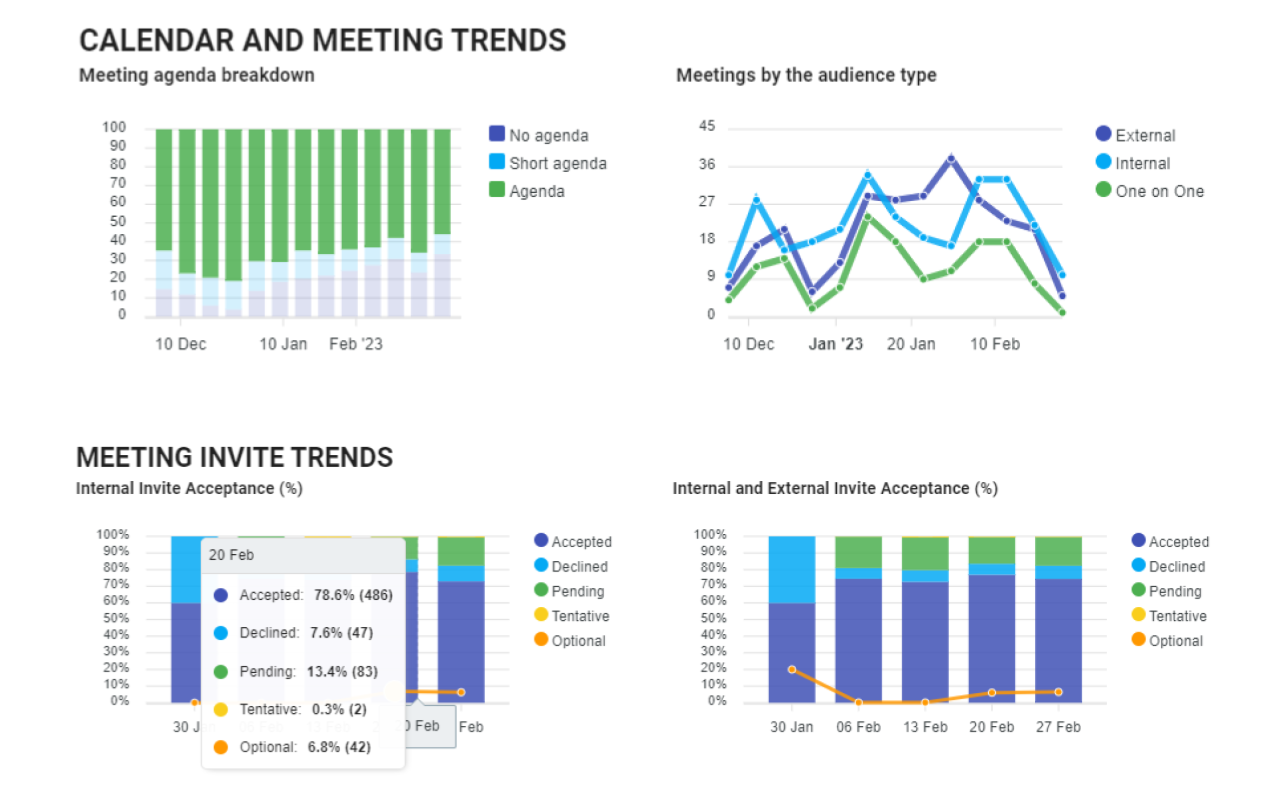
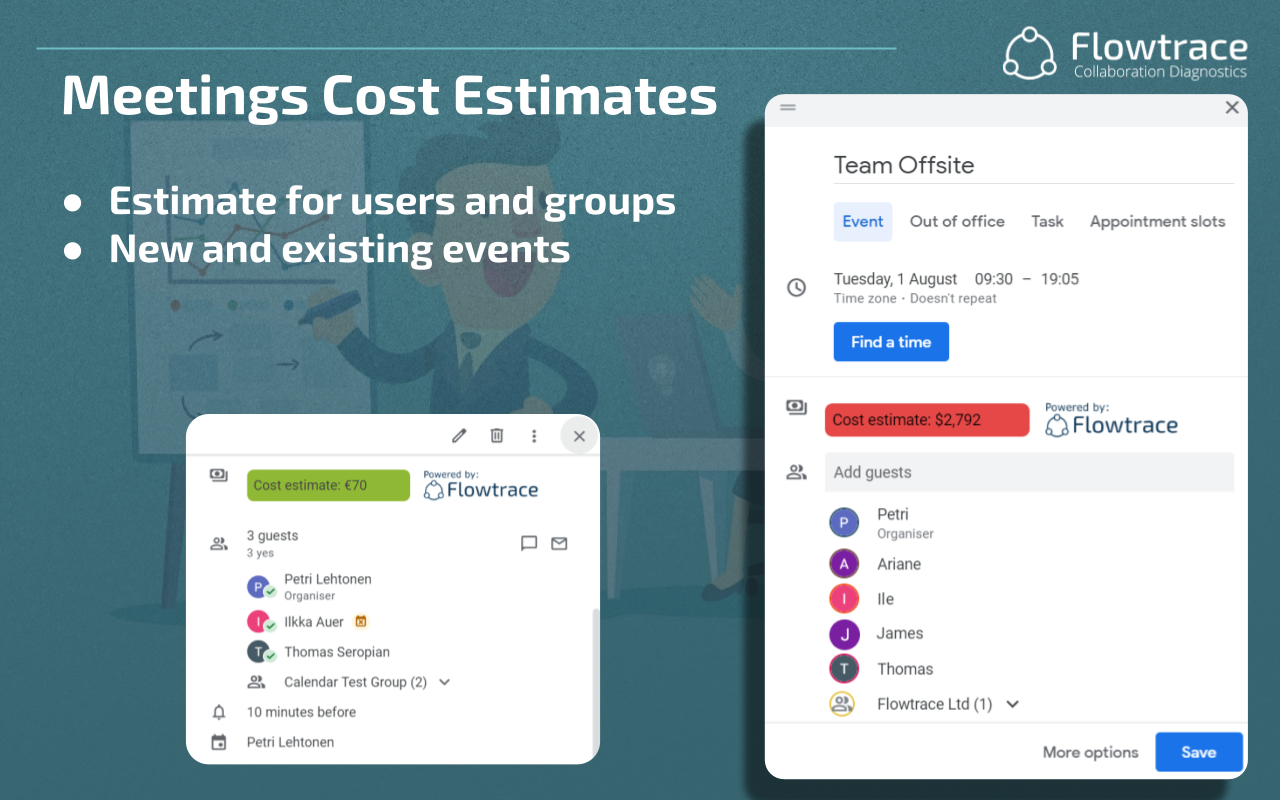
By providing detailed analytics on meeting efficiency and effectiveness, Flowtrace helps executives make informed decisions about meeting structures, agendas, and participant engagement. Executives can use these insights to streamline meetings, ensuring they are more productive and aligned with strategic objectives.
Insights into participation and communication patterns enable executives to identify and address issues related to low engagement or unequal participation. By fostering a more inclusive and engaging meeting environment, executives can improve team morale and collaboration.
Regular reviews of meeting analytics allow executives to make ongoing adjustments to meeting practices, promoting a culture of continuous improvement. This ensures that meeting practices evolve with the changing needs of the organization, keeping meetings relevant and effective.
Adopting a data-driven approach to meeting management empowers executives to make informed decisions, foster a culture of accountability, and continuously improve meeting practices. Embracing tools like Flowtrace not only enhances meeting efficiency but also drives better business outcomes and fosters a more collaborative and engaged organizational culture. Executives are encouraged to leverage these insights to lead their teams effectively and achieve strategic objectives with greater efficiency.
Discover how analytics can revolutionize meeting productivity by optimizing schedules, enhancing engagement, and driving strategic decision-making...
Enhance meeting efficiency with data-driven insights on frequency, cost, and engagement. Optimize practices for productivity and cost savings with...
Transform your organization with data-driven meeting cultures. Learn how to optimize meetings, increase productivity, and drive better business...